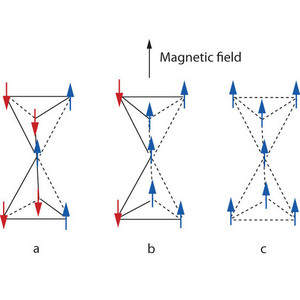Jul. 27, 2007 Research Highlight Physics / Astronomy
Breaking the frustration
The crystal structure of an oxide material is directly coupled to its ‘frustrated’ magnetic structure
 Figure 1: Breaking the frustration in HgCr2O4. (a) In low magnetic fields the material shows an antiferromagnetism for which the system compensates via a number of shortened atomic bonds (solid lines) compared with the symmetric, undistorted case (dashed lines). (b) & (c) As the magnetic field is increased, the magnetic moments align increasingly along the external field, while the structure assumes a less distorted configuration.
Figure 1: Breaking the frustration in HgCr2O4. (a) In low magnetic fields the material shows an antiferromagnetism for which the system compensates via a number of shortened atomic bonds (solid lines) compared with the symmetric, undistorted case (dashed lines). (b) & (c) As the magnetic field is increased, the magnetic moments align increasingly along the external field, while the structure assumes a less distorted configuration.
Researchers from the RIKEN SPring-8 Center in Harima, the Japan Atomic Energy Agency and the universities of Tokyo and Virginia have discovered how changes to the crystal structure of the oxide material HgCr2O4 correlate to its magnetic state.
HgCr2O4 has an intriguing crystal structure where all relevant atoms are arranged in tetrahedra (Fig. 1). When the interaction between the magnetic atoms at the corners of these tetrahedra is antiferromagnetic, a magnetic state with a zero net ‘moment’ is expected to occur—that is, there should be as many magnetic arrows pointing upwards as downwards. However, the geometry of the tetrahedra means that no perfectly homogeneous distribution of the moments is possible. This is known as ‘geometrically frustrated magnetism’.
To break the frustration, the system compensates for the uneven distribution of magnetic moments by distorting the crystal lattice (Fig. 1a). However, in response to an increasing external magnetic field, the magnetic moments realign and there is a stepwise reduction in crystal distortion (Fig. 1b). Once all magnetic moments are forced to point in the same direction, a perfectly symmetric crystal structure is assumed (Fig. 1c).
As reported in the journal Nature Physics 1, the research team studied the behavior of this material as they applied a slowly increasing magnetic field. They confirmed that the external magnetic field eventually breaks the zero magnetization of the sample and causes the magnetic spins to align along the external field—evidenced by sudden jumps in the sample magnetization followed by plateaus with constant magnetization.
Unlike other materials, HgCr2O4 is uniquely suited for this type of study, as these changes occur in magnetic fields small enough to be generated in experiments. Therefore, “the observation of magnetization plateaus in this compound over a wide range of magnetic fields is novel and a manifestation of the geometrical frustration,” explains Koichi Katsumata from the RIKEN team.
Importantly, the researchers studied for the first time the simultaneous evolution of the material’s crystal structure and found that as the magnetization jumps between the different plateaus, the crystal structure becomes less distorted (Fig. 1). Katsumata is therefore confident that this study “has unveiled the origin of some of the intriguing properties of geometrically frustrated magnets.” In particular, the results allow the validation and refinement of theoretical models describing the interaction between magnetism and crystal structure not only in this compound, but also in related systems.
References
- 1. Matsuda, M., Ueda, H., Kikkawa, A., Tanaka, Y., Katsumata, K., Narumi, Y., Inami, T., Ueda, Y. & Lee, S.-H. Spin-lattice instability to a fractional magnetization state in the spinel HgCr2O4. Nature Physics 3, 397–400 (2007). doi: 10.1038/nphys586
